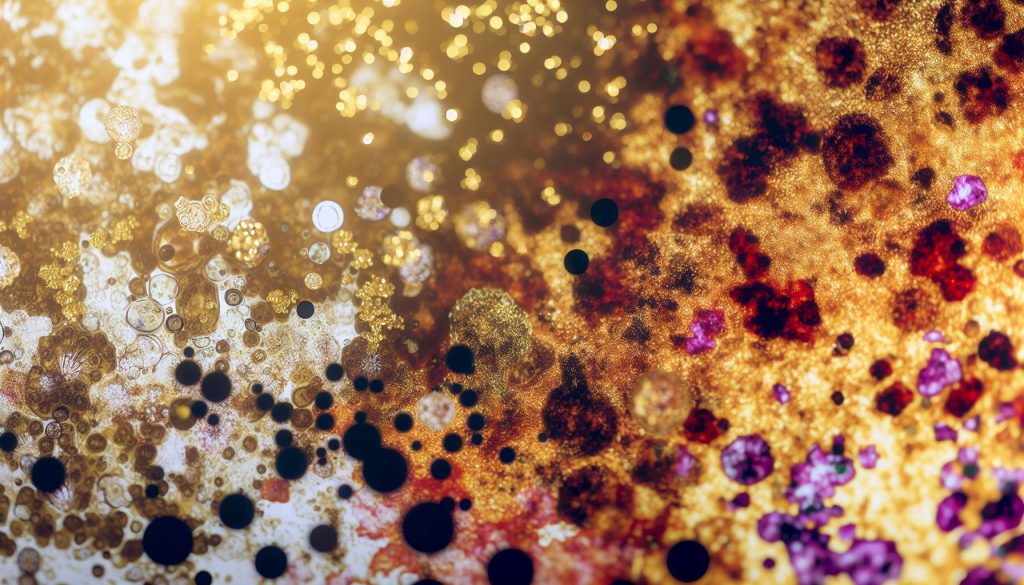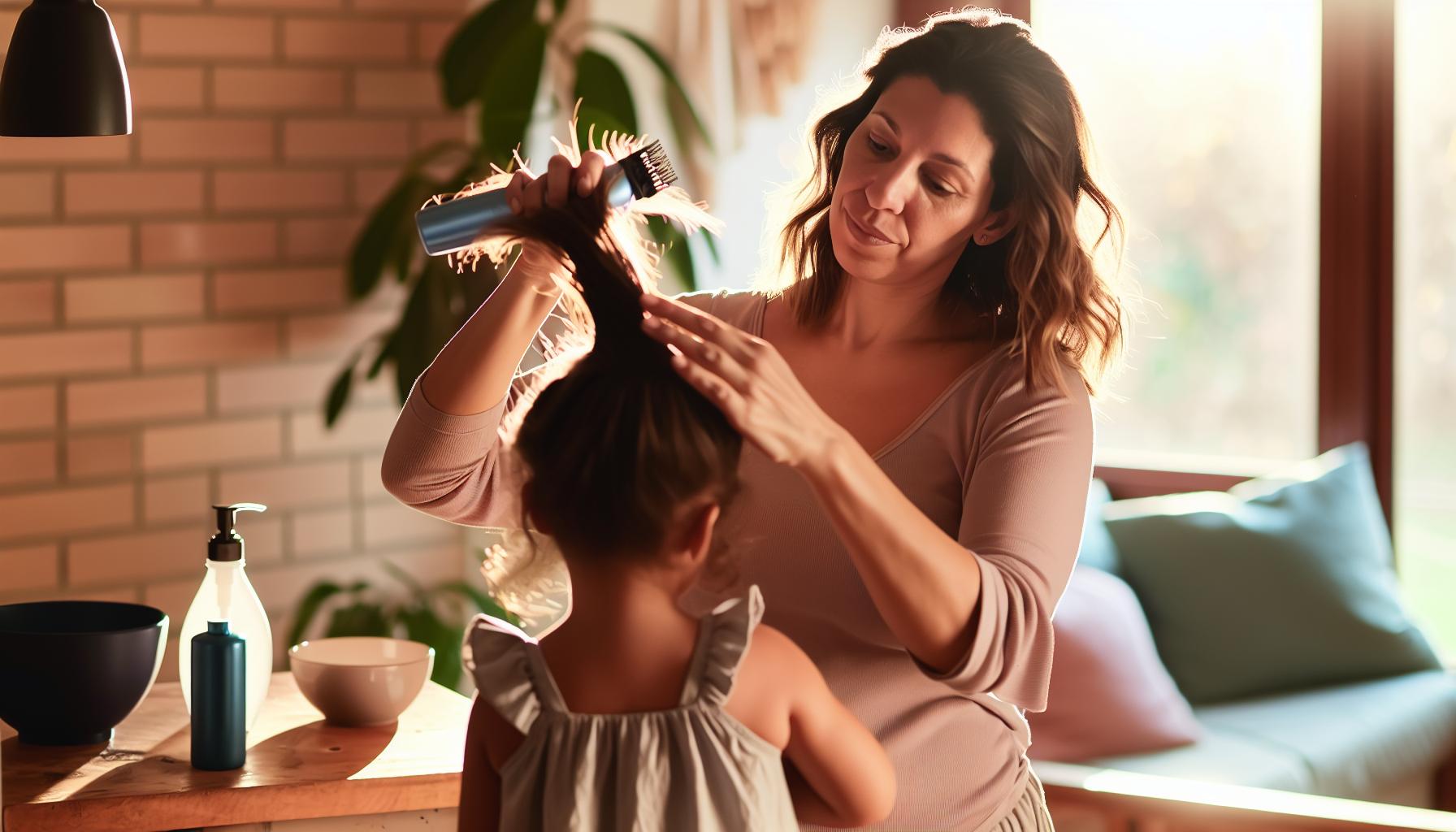Navigating the challenges of new motherhood frequently enough includes unexpected hair woes, like excessive greasiness. Understanding the causes and exploring quick solutions is crucial for new moms looking to regain confidence. From hormonal changes to busy routines, tackling postpartum oily hair is essential for feeling refreshed and ready to embrace motherhood.
Understanding postpartum Hair Changes: What’s Happening to Your Locks?
Understanding the Shift: What’s Happening to Your Locks?
For many new mothers, the joy of welcoming a baby is accompanied by unexpected changes to their hair. After childbirth, it’s common to experience a range of hair alterations, including increased greasiness, shedding, and texture changes. This phenomenon is primarily driven by a dramatic shift in hormone levels, especially after delivery, which can lead to what is colloquially known as baby hair.
Postpartum Hair Loss and Shedding
Approximately three months after giving birth, many women begin to notice an increase in hair shedding. This is due to the hormonal fluctuations that impact the hair growth cycle, which can cause hair to enter the shedding phase prematurely. Hair loss may peak around four months postpartum and can last for up to six months. While this can be alarming, it is often a temporary phase, with most women seeing a return to normalcy within a year. Interestingly, during pregnancy, hormonal changes often result in thicker, healthier hair, making the subsequent shed even more noticeable.The Greasy Hair Dilemma
Alongside shedding, many new moms report dealing with greasy hair postpartum. This condition can stem from several factors including hormonal imbalances, breastfeeding, and changes in hair care routines in the hectic early weeks of motherhood. The natural oils that would typically nourish hair may accumulate without regular washing, leading to an unkempt appearance. This can feel particularly frustrating during a time when personal care seems more challenging than ever.
- Maintain a Regular washing Schedule: While daily washing may not be necessary, aim for every other day to keep oil at bay.
- Use Dry Shampoo: This can be a lifesaver. It absorbs excess oil and adds volume, making it a quick fix for those days when you feel like you have no time to wash your hair.
- Consider Hair Products Wisely: Look for lightweight, oil-free shampoos and conditioners that won’t overload your hair with additional oils.
- Stay Hydrated and Balanced: A well-rounded diet and adequate water intake will support overall health, including your scalp and hair health.
Understanding what happens to hair postpartum can empower new moms to tackle these changes head-on, turning what can be a frustrating experience into a manageable one. Knowing the science behind these shifts can ease concerns and encourage the adoption of effective hair care strategies that suit their new lifestyle.
Quick and Easy Hair Care Tips for Busy New Moms
Effortless Hair Care Solutions for Moms on the Go
The whirlwind of motherhood can leave little time for personal care, especially when grappling with greasy hair postpartum. Navigating through sleepless nights and demanding schedules doesn’t mean sacrificing your hair’s health. Simple yet effective techniques can swiftly transform your locks, allowing you to feel fresh and confident even on the busiest days.
- Dry Shampoo Magic: A lifesaver, dry shampoo absorbs excess oil and adds volume. Simply spray it onto your roots,let it sit for a couple of minutes,and then brush through. This quick fix can provide that much-needed lift on days when washing your hair feels impossible.
- Choose the Right Hair Products: Opt for lightweight shampoos and conditioners that are specifically designed for oily hair. These products provide a thorough cleanse without weighing hair down. Look for those free from silicones, which can enhance greasiness.
- Scalp Care: Keep your scalp clean to manage oil production. Regular gentle exfoliation can help remove buildup, promoting a healthier scalp. You can easily DIY a scalp scrub using sugar and your favorite natural oil.
- Simple Updos: If your hair is looking less than perfect, an elegant top knot or a stylish braid can be your best friend.Not only do these styles hide greasy roots, but thay also save time getting ready!
Incorporating Hydration and Nutrition
While topical solutions help, internal factors play a crucial role in hair health.Ensuring you stay hydrated by drinking enough water can help balance oil production. Pair this with a diet rich in vitamins and minerals, focusing on foods that support hair health such as leafy greens, nuts, and lean proteins. Adding omega-3 fatty acids can also reduce inflammation and enhance scalp vitality, ultimately combating postpartum hair issues.
| Hair-Friendly Foods | Benefits |
|---|---|
| Spinach | Rich in iron and vitamins A and C for healthy oils in the scalp |
| Salmon | High in omega-3 fatty acids for scalp hydration |
| Eggs | Packed with protein and biotin to promote hair strength |
| Nuts | Provide essential fatty acids that keep hair nourished |
by incorporating these quick and easy hair care tips, busy new moms can effectively tackle greasy hair postpartum while prioritizing their well-being. Embrace these strategies to not only manage your hair but also to reclaim some of your personal time and confidence.
Choosing the Right Products for Oily Postpartum Hair
Understanding Oily Hair in New Moms
The postpartum period brings about a whirlwind of hormonal changes that can dramatically affect your hair—especially if you’ve noticed issues with oiliness. It’s not uncommon for new mothers to experience greasy hair postpartum, which can make daily styling feel like an uphill battle. Choosing the right products is crucial in managing this condition effectively.
Selecting the Best Products
to combat oily hair, focus on lightweight, oil-controlling products that cleanse without overburdening your hair. Consider the following tips when selecting your regimen:
- Volumizing Shampoo: Look for shampoos specifically formulated to add volume. These products typically do not contain heavy conditioners, which can build up and lead to an oily appearance. Avoid any shampoo labeled as ‘conditioning’ to prevent your hair from feeling weighed down [[2](https://www.aad.org/public/diseases/hair-loss/insider/new-moms)].
- Sulfate-Free Formulas: Choose gentle, sulfate-free shampoos that clear excess oil without stripping your hair of its natural moisture. This is especially meaningful for maintaining a healthy scalp environment [[3](https://www.hopkinsmedicine.org/health/wellness-and-prevention/postpartum-hair-loss)].
- Dry Shampoo: Investing in a good dry shampoo can be a lifesaver.It helps absorb excess oils and revitalizes limp strands in mere minutes, making it a staple for new moms facing time constraints.
- Clarifying Shampoo: Use a clarifying shampoo once a week to remove buildup and excess oil. This product should be used sparingly, as too frequent use can lead to dryness [[2](https://www.aad.org/public/diseases/hair-loss/insider/new-moms)].
DIY Solutions
If you’re seeking cost-effective solutions, some at-home remedies can double as quick fixes for oily postpartum hair struggles. Consider the following options:
- Baking Soda: Create a paste with baking soda and water to gently scrub your scalp. This can definitely help absorb grease without harsh chemicals.
- Apple Cider Vinegar Rinse: Dilute apple cider vinegar with water and use it as a rinse after shampooing. It helps restore pH balance and removes excess product residue.
By carefully selecting your hair care products and incorporating some simple DIY solutions, you can effectively manage oily hair during this transitional phase. Embrace the journey of new motherhood with the confidence that you can maintain both healthy hair and peace of mind!
Refreshing Hairstyles to Hide Greasy Roots
Effortless Styles for Oily Roots
struggling with greasy roots is a common challenge for new moms, especially when time is limited and self-care often takes a backseat. Fortunately, there are numerous hairstyles designed to help disguise oily hair while keeping you looking fresh and put together. These quick and easy styles not only save time but also boost your confidence, allowing you to shine even on wash day.
- Messy Bun: This versatile hairstyle screams effortless chic. Gather your hair into a high or low bun and let some strands fall naturally to frame your face. You can even add a headband or scarf for an extra touch.
- Low Sleek Ponytail: Comb your hair back into a low ponytail, smoothing the roots with a little hair serum or gel. This style not only looks polished but also keeps hair neatly out of your face.
- Half-Up Half-Down: This look combines the best of both worlds. Pin the top half of your hair back while leaving the rest down,which helps to conceal greasiness at the roots while letting your hair flow.
- Space Buns: Divide your hair into two sections and twist them into buns at the top of your head. This playful style is perfect for days when you want to feel fun and youthful.
additional Tips for Freshening Up
If you find yourself in a pinch, there are a few tricks to keep in mind.Consider using dry shampoo, which can absorb excess oil and provide volume to flat roots. Simply spray at the roots, let it sit for a few minutes, and brush it out for an instant refresh.Furthermore, incorporating accessories like headbands or hats can effectively divert attention away from greasy roots while adding a stylish flair to your look.
For those longer hair lengths, braids can also be your best friend. They not only secure hair away from your face but also add texture and interest, creating an ideal look when you’re dealing with greasy hair postpartum. Embrace these styles as quick fixes, allowing you to focus on what matters most—enjoying precious moments with your little one.
Natural Remedies to Combat Oily Hair After Baby
Dealing with oily hair postpartum can be challenging, especially when new moms are juggling countless responsibilities. This increase in oil production is often a result of hormonal changes, lack of sleep, and stress, all of which come into play after giving birth. Fortunately,various natural remedies can definitely help restore balance and vitality to your hair.
- Apple Cider Vinegar rinse: This natural remedy helps to remove excess oil and buildup from the scalp. Mix one part apple cider vinegar with two parts water, apply it after shampooing, and rinse thoroughly. The acidity of the vinegar helps to restore the pH balance, making it a great choice for oily hair.
- Use Aloe Vera Gel: Known for its soothing properties, aloe vera can effectively reduce oiliness. apply fresh aloe vera gel directly to the scalp, leave it on for about 30 minutes, and then rinse with a mild shampoo.
- Baking Soda Treatment: Baking soda acts as a natural absorbent. Create a paste by mixing water with baking soda and apply it to your scalp. Leave it on for 15-20 minutes before rinsing. This can help remove excess oil and leave your hair feeling fresh.
- dry Shampoo with Cornstarch: When time is of the essence, homemade dry shampoo can be a lifesaver. Mix cornstarch with a few drops of essential oil (such as lavender or tea tree) for a quick oil-absorbing solution. Apply it to the roots, let it sit for a few minutes, and brush out.
these remedies not only combat oily hair but also rejuvenate the scalp naturally, making them perfect for new moms seeking quick fixes for greasy hair postpartum. Incorporating these methods into your hair care routine can definitely help you regain confidence and manage your hair’s oiliness while you focus on the joys of motherhood.
expert Tips for Maintaining Healthy Scalp and Hair
Understanding Your Scalp’s Needs Postpartum
After childbirth, many new moms experience overactive oil glands that can leave hair feeling greasy and unmanageable. This is often attributed to hormonal shifts and can lead to a variety of scalp issues. To maintain a healthy scalp and hair,it’s crucial to adopt a regimen that caters specifically to postpartum changes. Start by identifying the right cleansing routine; using a gentle, moisturizing shampoo can alleviate itching and discomfort while addressing oiliness. Regular washing is key,but be mindful to adjust the frequency based on your scalp’s response to treatment.
Essential Practices for Scalp Care
To enhance the health of both scalp and hair, consider incorporating the following practices into your routine:
- Choose Gentle Hair Products: Opt for shampoos and conditioners free from harsh sulfates and silicones. These ingredients can exacerbate oiliness and lead to buildup on the scalp.
- Hydration and Nutrition: Maintain hydration by drinking plenty of water and include foods rich in omega-3 fatty acids, like salmon and walnuts, to nourish your scalp. Nutrients such as vitamin A from spinach and carrots can also promote a healthy scalp environment.
- Regular Scalp Treatments: Incorporate scalp treatments or oil massages to balance oil production and restore moisture. Ingredients like tea tree oil can definitely help soothe irritation and prevent buildup.
Quick Fixes for Greasy Hair
If you’re in a pinch, there are several quick fixes that can help manage greasy hair postpartum:
| Quick Fix | Description |
|---|---|
| Dry Shampoo | A lifesaver for busy moms, dry shampoo absorbs excess oil and adds volume, making hair look fresh between washes. |
| Baby Powder | In case of a dry shampoo shortage, a light sprinkle of baby powder can effectively soak up oils at the roots. |
| Hairstyles | Embrace updos or braids to divert attention from greasy roots while keeping hair manageable. |
| Scalp Massages | Stimulating your scalp with a gentle massage can promote blood flow and help regulate oil production. |
By understanding the unique challenges of postpartum hair care and implementing these expert tips, new moms can restore their hair’s vitality and maintain a healthy scalp, countering the struggles associated with greasy hair postpartum.
The Role of Nutrition in Managing Greasy Hair Post-Baby
the Impact of Nutrition on Greasy Hair After Pregnancy
Navigating the world of motherhood can be overwhelming, especially when it comes to self-care—like managing greasy hair. Postpartum hormonal changes can increase oil production in the scalp, leading to greasy hair. Though, your diet plays a crucial role in either exacerbating or alleviating this condition. Focusing on essential nutrients can definitely help regulate oil production and promote hair health.
To combat greasy hair postpartum, consider incorporating foods rich in omega-3 fatty acids, vitamins, and proteins. These nutrients not only nourish your hair but also help balance your body’s oil production.Here are some dietary recommendations:
- Omega-3 Fatty Acids: Found in fish like salmon and walnuts, these healthy fats can reduce inflammation and help balance the scalp’s oil production.
- High-Quality Proteins: Eggs, lean meats, and legumes provide the building blocks for healthy hair growth and can definitely help regulate oiliness.
- Vitamins A and E: Carrots, spinach, and avocados are excellent for overall skin health, including maintaining a healthy scalp.
Moreover, it’s essential to steer clear of processed foods that may lead to increased oiliness. Diets high in refined carbohydrates and saturated fats can trigger overproduction of sebum, resulting in greasier hair. Aim to limit sugary snacks and fried foods, replacing them with whole grains and fresh fruits. This shift not only supports healthier hair but also enhances overall well-being.
For many new moms, balancing nutrition with a busy lifestyle can be challenging, but small changes can lead to significant improvements. By focusing on a balanced diet and staying hydrated, you can better manage greasy hair while also nourishing your body during the postpartum phase.
| Food Group | Beneficial Nutrients | Examples |
|---|---|---|
| Healthy Fats | Omega-3 Fatty Acids | Salmon, Walnuts, Chia Seeds |
| Proteins | High-Quality Protein | Chicken, Eggs, Lentils |
| Fruits & Vegetables | Vitamins A and E | Carrots, Spinach, Avocados |
By understanding the connection between what you eat and how your hair looks, you can take actionable steps to manage greasy hair postpartum effectively. Adopting healthier eating habits not only benefits your hair but also enhances your energy levels and mood as you navigate the joyful yet demanding journey of motherhood.
Embracing Your New Look: confidence-Building Strategies for New moms
Rediscovering your Best Self
Having a baby brings a whirlwind of changes, not only to your routine but also to how you perceive yourself. Postpartum, many new moms struggle with changes in their bodies and hair, often leading to feelings of decreased confidence. However, with the right strategies, it’s possible to embrace this new chapter with style and confidence. Prioritizing self-care is essential; you deserve moments that uplift your spirit and revitalize your appearance.
Quick Fixes for Greasy Hair
When it comes to dealing with greasy hair postpartum, quick solutions can significantly enhance your confidence. Here are a few effective strategies:
- Dry Shampoo: A lifesaver for busy moms, dry shampoo absorbs excess oil and adds volume. Spray it in the roots, let it sit for a few minutes, and brush through.
- Scheduled Wash Days: Establish a consistent washing routine that works with your schedule. this might mean washing every other day or even less frequently, depending on your hair type.
- Hairstyles that Hide Grease: Embrace hairstyles like braids or buns that cleverly conceal oily roots while looking stylish.
- Natural Remedies: Home solutions, such as apple cider vinegar rinses or cornstarch, can help absorb oil and refresh hair without stripping it of natural moisture.
Building Confidence Through style
Transforming the way you feel about your appearance can significantly impact your confidence. Start by experimenting with your wardrobe and hair to find styles that make you feel good. Consider these practical steps to enhance your look:
- Accessorize: A trendy hat or headband can divert attention from greasy hair and elevate your outfit instantly.
- Invest in Quality Hair Products: gentle shampoos and nourishing conditioners can improve your hair’s health over time, making it easier to manage.
- Prioritize Nutrition: A balanced diet full of vitamins can promote healthy hair growth and overall well-being, contributing to a more radiant appearance.
- Connect with Other Moms: Share experiences and tips with fellow mothers; this can provide not only practical solutions but also emotional support on your journey.
By embracing these simple yet effective strategies to combat greasy hair postpartum, you can rediscover your confidence and present the best version of yourself, even on the busiest of days. Remember, it’s about finding what works best for you while celebrating the beauty of motherhood.
Faq
What causes greasy hair postpartum?
Greasy hair postpartum is often caused by hormonal changes. After childbirth, fluctuating hormone levels can lead to increased sebum production in the scalp.
This excess oil can make your hair appear dull and lifeless. Additionally, factors like stress and changes in hair care routines can contribute to this issue. For more tips on managing oily hair, consider exploring this guide.
how can I manage greasy hair postpartum?
To manage greasy hair postpartum, try using a lightweight shampoo and wash your hair regularly to control oil buildup.
A dry shampoo can also be a lifesaver, extending the time between washes while absorbing excess oil. Furthermore, embracing hairstyles like braids or buns can help you feel more put together while managing greasy locks.
Can diet affect greasy hair postpartum?
Yes, your diet can significantly impact the oiliness of your hair. Consuming a balanced diet rich in vitamins can help regulate oil production.
Foods high in omega-3 fatty acids, such as salmon and walnuts, can promote healthier hair.Additionally, staying hydrated is essential for overall hair health. Make sure to include plenty of fruits and vegetables in your meals to support your body’s needs during this postpartum phase.
What are quick fixes for greasy hair postpartum?
For quick fixes, consider using dry shampoo, which can instantly absorb excess oil and freshen up your hair.
You can also try fluffing your hair with a volumizing spray or switching to hairstyles that pull hair back,such as ponytails or buns. These tricks can help you feel more confident while managing greasy hair postpartum.
Why is my scalp oily but my hairdry?
An oily scalp with dry hair postpartum can occur due to product buildup or the use of harsh shampoos that strip moisture from your hair while not effectively removing excess sebum.
To balance this, use a sulfate-free shampoo that cleanses the scalp without drying out the hair. Incorporate moisturizing conditioners focused on the hair ends to help alleviate dryness.
Can hormonal changes during breastfeeding cause oily hair?
Yes, hormonal changes during breastfeeding can lead to oily hair as your body tries to adjust to new hormone levels.
These changes can stimulate your sebaceous glands and increase oil production. Keeping a consistent hair care routine and choosing the right products can help manage greasy hair effectively during this period.
Are there specific products for greasy hair postpartum?
Yes, look for products specifically formulated for oily hair, such as clarifying shampoos and lightweight conditioners.
These products can help reduce excess oil and prevent buildup. Additionally, consider using natural oils sparingly, focusing on products that provide a refreshing feel without weighing your hair down.
How often should I wash my hair if it is greasy postpartum?
If you have greasy hair postpartum, washing it every other day can be effective.This frequency can help control oil without over-drying your scalp.
However, listen to your hair’s needs. If your hair feels greasy, don’t hesitate to wash it more often. Always opt for gentle shampoos to maintain a healthy scalp environment.
To Wrap It Up
As you navigate the postpartum journey, it’s completely normal to face challenges like greasy hair. Remember that maintaining a balanced diet and using gentle, sulfate-free shampoos can be great for your hair’s health and help combat excess oil. Consider incorporating volumizing products, and always handle your hair gently to reduce breakage. If you’re feeling overwhelmed, know you’re not alone—many new moms experience this. Embrace easy fixes like dry shampoo for a quick refresh between washes, and experiment with hairstyles that keep your hair looking fresh even on the most hectic days. You’re doing an amazing job, and taking time for yourself—whether it’s pampering your hair or just taking a moment to breathe—is essential. For additional tips and personal stories shared by other moms, feel free to explore our resources further. you’re not just managing hair; you’re nurturing yourself amidst all the changes of motherhood. Keep shining, and take it one day at a time!







